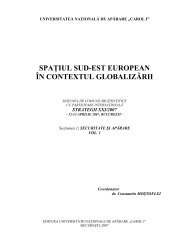PROVOCĂRI LA ADRESA SECURITĂŢII ŞI STRATEGIEI LA ÎNCEPUTUL SECOLULUI XXI
provocări la adresa securităţii şi strategiei la începutul secolului xxi
provocări la adresa securităţii şi strategiei la începutul secolului xxi
You also want an ePaper? Increase the reach of your titles
YUMPU automatically turns print PDFs into web optimized ePapers that Google loves.
_ Last, but not least, Wider Europe is not a unilateral venture. EU<br />
will be discussing with Russia on the areas of common interest within this<br />
initiative.<br />
The aim is to strengthen our strategic partnership. Wider Europe<br />
will enrich and provide focus, and value added to it, while of course it will<br />
also benefit our other neighbours. The times of zero-sum reasoning in EU-<br />
Russia region are past. Co-operative approaches are today the name of the<br />
game. And Russian participation in EU neighbourhood policy forms an<br />
obvious and integral part of such an approach.<br />
II. Relations between the European Union and the Western<br />
News Independent states<br />
The Union of 25 will acquire two new neighbours to the East,<br />
Belarus and Ukraine, while a third one, Moldova, will be added, with<br />
Romania’s accession.<br />
1. Relations between the European Union and Ukraine<br />
The Partnership and Cooperation Agreement (PCA) was concluded<br />
in 1994 and entered into force in March 1998. The PCA forms the legal<br />
basis of EU-Ukraine relations, providing for cooperation in a wide range of<br />
areas including political dialogue, trade and investment, economic and<br />
legislative cooperation, and cultural and scientific cooperation. The parties<br />
recall the common values that they share, and state their commitment to<br />
promote international peace and security as well as the peaceful settlement<br />
of disputes, and agree that respect for democratic principles and human<br />
rights as well as for the principles of market economy underpin their internal<br />
and external policies and constitute an essential element of partnership and<br />
of the Agreement.<br />
Article 51 of the PCA recognises the importance of legislative<br />
approximation for strengthening economic links between Ukraine and the<br />
EU and identifies a number of priority areas. Since late 2002 Ukraine, with<br />
EU assistance, has sought to reinforce structures, planning and its approach<br />
to defining goals and tasks in pursuit of its legislative approximation<br />
programme. To this end a draft legislative approximation scoreboard is<br />
under preparation in order to assist in prioritisation and measure progress.<br />
The EU is the largest donor to Ukraine. Total assistance since 1991<br />
amounted to more than €1 billion. This includes technical assistance through<br />
the TACIS programme, macro-financial assistance, and humanitarian<br />
assistance. TACIS assistance in the area of nuclear safety alone amounted to<br />
almost €260 million over 1991-2003. Assistance also includes the Fuel Gap<br />
programme and a major contribution to the Chernobyl Shelter Fund<br />
managed by the EBRD.<br />
The main objectives of the TACIS programme are to reinforce<br />
democracy and the rule of law and to promote the transition to a market<br />
economy in the partner countries of Eastern Europe and Central Asia. In<br />
recent years assistance has been progressively focused on support for<br />
institutional, legal and administrative reform; support to the private sector<br />
and for economic development; and support to address the social<br />
consequences of transition.<br />
The current TACIS cross-border co-operation (CBC) programme<br />
(2004-2006) reflects the objectives of the European Neighbourhood Policy:<br />
to allow partners on both sides of the EU’s external border to work jointly to<br />
address common challenges such as economic and social development of<br />
the border areas, environment and communicable diseases, illegal<br />
immigration and trafficking, efficient border management and people-topeople<br />
contacts.<br />
The Neighbourhood Programmes (2004-2006) are based on the<br />
existing funding instruments, Tacis CBC, INTERREG and Phare CBC.<br />
Three bilateral/trilateral programmes will be prepared between Ukrainian<br />
regions and partner regions in Poland, Hungary, Slovakia, Romania and<br />
Belarus, supplemented by one regional/transnational Neighbourhood<br />
Programme (CADSES). The indicative allocation of funding for Ukraine<br />
amounts to approximately €20 million (2004-2006).<br />
The Union recently extended until December 2004 the 1999<br />
Common Strategy for Ukraine. The Strategy aims at developing a strategic<br />
partnership between the EU and Ukraine on the basis of the PCA, while<br />
acknowledging Ukraine’s European aspirations and welcoming the<br />
country’s European choice.<br />
Ukraine adopted in 1998 a Strategy for European Integration. In<br />
early 2002, President Kuchma declared EU membership a long-term goal,<br />
with Ukraine aiming to fulfill the relevant criteria for lodging an application<br />
by 2011.<br />
Through this year’s enlargement of the European Union, the Union<br />
and Ukraine have become direct neighbours. The EU-Ukraine Summit of<br />
October 2003 acknowledged the “broad range of new opportunities” offered<br />
by the European Neighbourhood Policy, which “should facilitate Ukraine's<br />
progressive participation in the EU’s internal market and in EU policies and<br />
programmes, taking into account Ukraine’s strategic goals and priorities”.<br />
Ukraine noted the EU position that this policy should be seen as distinct<br />
311<br />
312





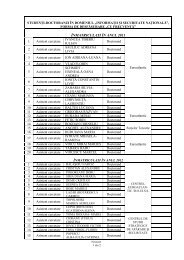
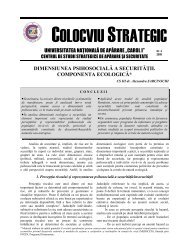
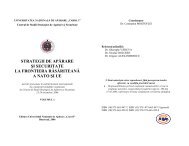
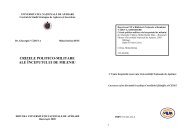
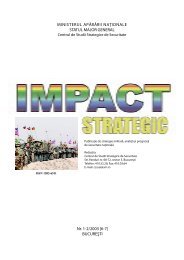


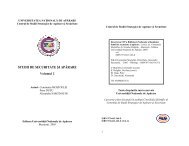

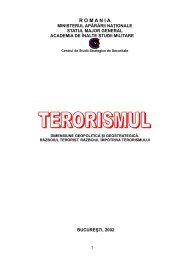
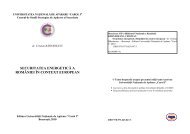
![„CAROL Nr 4 [29]/2008](https://img.yumpu.com/53801719/1/184x260/carol-nr-4-29-2008.jpg?quality=85)
